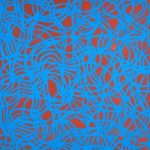-
Artworks
Sol LeWitt
Irregular Grid, 2001Gouache on paper45 1/8 × 42 1/2 in (114.6 x 108 cm)© 2025 Sol LeWitt / Artists Rights Society (ARS), New York. Courtesy of Zeit Contemporary Art, New YorkFurther images
Sol LeWitt’s Irregular Grid, 2001, presents an extraordinary confluence of geometry and gesture, standing as a crowning example of the artist's late-career engagement with gouache. Measuring 45 1/8 × 42...Sol LeWitt’s Irregular Grid, 2001, presents an extraordinary confluence of geometry and gesture, standing as a crowning example of the artist's late-career engagement with gouache. Measuring 45 1/8 × 42 1/2 inches, the work exudes an expansive energy that transcends its medium, echoing the monumental quality of LeWitt's iconic wall drawings. The dynamic blue grid, interwoven with rhythmic irregularities, dances atop a vivid red ground, offering a visual symphony of line and color. This interplay between structure and spontaneity embodies LeWitt’s ability to transform rigid conceptual frameworks into deeply expressive visual experiences.
Materially, the gouache technique plays a pivotal role in this transformation. Unlike the precision of ink or the permanence of acrylic, gouache allows for a velvety, almost luminous surface, enhancing the tactile and gestural qualities of LeWitt’s lines. The hand-drawn grid is both controlled and fluid, a testament to the artist’s mastery over his medium. Here, the physicality of the material resonates with the artist's philosophical leanings—emphasizing the process as much as the product. The subtle variations in line thickness and the intensity of the blue pigment breathe life into the composition, elevating the work beyond mere geometry into the realm of organic complexity.
Visually, the work achieves a remarkable balance between chaos and order. The irregular grid suggests movement and flux, as if the lines are caught in a perpetual state of becoming. Yet, within this apparent randomness lies an underlying harmony—a reflection of LeWitt's belief that systems, even when disrupted, retain an inherent logic. The vibrant red background serves as an arresting counterpoint, imbuing the composition with warmth and depth. Together, these elements create a sense of expansiveness, as though the grid could extend infinitely beyond the paper’s edges, invoking the immersive quality of LeWitt’s large-scale wall works.
LeWitt's artistic outlook in this remarkable series of gouaches was profoundly influenced by his admiration for Indigenous Australian artist Emily Kame Kngwarreye, whose work he collected extensively. He was captivated by her intuitive approach to abstraction, marked by rhythmic patterns and a deep spiritual connection to the land. This unexpected dialogue between their practices reveals shared concerns with repetition, gesture, and the interplay of structure and spontaneity. LeWitt’s passion for Kngwarreye’s art extended beyond personal admiration: he eventually donated a significant portion of his collection of her works to the Art Gallery of New South Wales in Sydney. This cultural exchange underscores the universal resonance of abstraction across different artistic traditions, illuminating Irregular Grid as not just a conceptual experiment but a deeply human response to visual and emotional rhythm.
NOTES
This artwork is signed and dated in the lower right corner.
Provenance
Pace Wildenstein Gallery, New York,
Private collection, United States
Private Collection, New York








